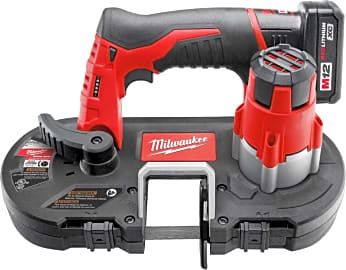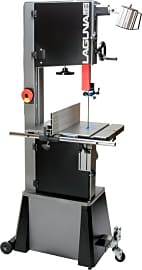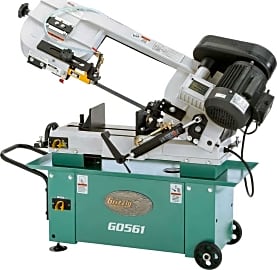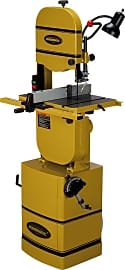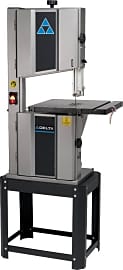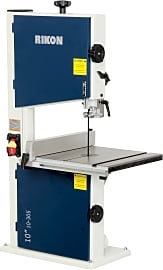The 10 Best Band Saws

This wiki has been updated 38 times since it was first published in June of 2015. A high quality band saw provides accurate cuts right where you need them, on metal, wood, or plastic. Whether you are a professional contractor or a home DIYer, one of the tools on this list will help you get the job done with efficiency and precision. We've ranked them by price, durability, performance, and ease of use, and included a mix of portable and stationary models. When users buy our independently chosen editorial recommendations, we may earn commissions to help fund the Wiki.
Editor's Notes
February 08, 2021:
During this round of updates, while most of our previous picks continued to be great selections for this space, we ended up removing the Jet Deluxe Pro and Grizzly G0513ANV, due to availability issues.
To replace these models, feeling that our list already had enough cabinet-style representation, we added two new portable models to our rankings: the Metabo HPT CB18DBLQ4 Starter Kit and Bosch GCB10-5. While the CB18DBLQ4 is a battery-powered model that comes complete with two, three-amp-hour batteries and a USB-port-equipped charger, the GCB10-5 is a corded model with an impressive 4-3/4-inch cut capacity.
We also decided to eliminate the DeWalt DCS371B – a medium-duty model that was offered as a bare tool – and replaced it with the DeWalt DCS376P2 — a hefty, 24-pound brushless selection that can handle rectangular stock as large as five inches by 4-3/4 inches. It should be noted that, while a previous two-handed option from DeWalt was unable to accommodate the company’s high-capacity Flexvolt batteries, due to their increased size interfering with one of the tool’s handles, this one purportedly doesn’t present the same problem.
April 10, 2019:
Based on user reports, one of the only significant downsides to the Grizzly G0513ANV is the blade that comes with it — if you purchase a higher quality blade separately, you should be all set with an impressive, powerful tool.
Added the Milwaukee M12, in part to provide another compact, portable model for those who need flexibility for light-duty applications. Users appreciate its lightweight design, lack of noise and vibration, and the ability to use it with one hand, particularly for overhead work. Also included the Grizzly G0513ANV — this is a large, freestanding model that comes with a host of useful features, such as a miter gauge, a blade tensioning lever, and a blade tracking window. For its cost and effectiveness, it’s a nice value, but those who work in certain professional trades may want to consider something a bit more advanced.
Eliminated the Skil 3386-01 2.5-Amp and the Wen 3962 from the list; the former due to multiple complaints that the blade guides are extremely difficult to adjust (which leads to erratic cutting) as well as a number of reports of components breaking down after only a few uses. Many users of the Wen 3962 were victims of a significant lack of durability as well, which is one of the reasons we removed it.
A Brief History Of The Bandsaw And Its Many Patents
In his patent, Barker describes a bandsaw with a 34-foot-long blade with a 5-foot diameter.
The first ever patent for a bandsaw was issued in 1809 to William Newberry, but the first actual bandsaw wasn't built until the 1860s. This is because no one could manufacture a viable blade that could withstand the constant flexing a bandsaw's blade experiences.
William Newberry's wasn't the only bandsaw patent issued before the actual invention of such a tool. In 1817, Adam Stewart received the first American bandsaw patent. Unfortunately, his patent was lost in the devastating patent office fire of 1836, so the only information left describing his invention is the title "band or belt saw." In 1836, the second American patent for a bandsaw was issued to Benjamin Barker. In his patent, Barker describes a bandsaw with a 34-foot-long blade with a 5-foot diameter. He believed the enormous size of the wheel would reduce the flexing it experienced thereby allowing it to stand up to the rigors of bandsaw cutting. This also proved to be a dead end, and it was never manufactured.
Barker's patent was followed quickly by a third American bandsaw patent, which was issued to William Cary, also in 1836. His featured an overly wide blade, also most likely to overcome problems with metallurgical properties in available steel at the time.
In 1846, a French women by the name of Anne Paulin Crepin developed a welding technique that was finally capable of creating a bandsaw blade that could handle the constant flexing. After patenting her method, she sold the rights to A. Perin & Company of Paris, who combined it with advanced tempering techniques and new steel alloys to create the first viable bandsaw blade. Once a blade was developed, bandsaws quickly spread throughout Europe and made their way to America by the end of the 1860s.
Types Of Band Saws
Stationary bandsaws can be differentiated into three main categories: metal bandsaws, wood bandsaws, and meat bandsaws. Metal bandsaws can be further broken down into vertical and horizontal models. Vertical versions are better for intricate work like contour cutting, polishing, and filing. Horizontal bandsaws are most often used to cut down stock to smaller sizes. Metal bandsaws can cut through a larger variety of materials than wood and meat bandsaws, making them the go-to choice for shops that need a versatile tool. They can even be used to cut blades for use in other types of bandsaws.
Wood bandsaws are often found in home and professional woodworking shops. There is no doubt that they are one of the most important power tools in any woodworker's arsenal. The blades of wood bandsaws are made with smaller kerfs to ensure less material is wasted when cutting. They operate in a similar manner to any other type of bandsaw, with a blade that is located on a continuous loop of metal. The main difference between metal and wood bandsaws, besides the blade that can be swapped for another type, is the speed at which they operate. A metal bandsaw is significantly slower and runs at speeds from 80 to 300 feet per second. A wood bandsaw runs at speeds from 2,000 to 3,000 feet per second. Some models have a variable speed transmission and are capable of cutting both types of materials.
Meat bandsaws are often found in meat factories and butcher shops. They are designed to cut through meat and bone to make breaking down animals more efficient. Most meat bandsaws are constructed entirely from stainless steel and are designed to be easily cleaned for obvious sanitary reasons.
What To Consider When Buying A Bandsaw
When it comes time to buy a bandsaw, the first thing to consider is what type of material you will be cutting most often. Next, you should look at the throat and depth of cut specifications. The throat refers to the distance between the vertical frame and the blade. This will determine how wide of a cut a particular bandsaw is capable of. When you see a bandsaw marketed as a "12-inch bandsaw" or a "20-inch bandsaw," they are referring to the throat.
The throat refers to the distance between the vertical frame and the blade.
In addition to the throat, the depth of cut measurement is very important, as this will determine how thick of a piece of stock you can cut. A bandsaw's depth of cut is the distance between the upper blade guide and the cutting table. Some models may have a riser which can be attached to increase the depth of cut.
The next consideration is the horse power of the motor on the bandsaw you are looking at. If the motor is not large enough, it may struggle and bog down when trying to cut dense materials, which will result in a rougher cut. The average home models have a 3/4 to 1HP motor, while professional models may have 12HP or more.
For those cutting metal, a model with a variable speed motor is a smart choice, while those who cut wood should look for a unit that features built-in dust collector ports. No matter what material you cut, most users can benefit from a model with a tilting cutting table, which allows for angled cuts.



